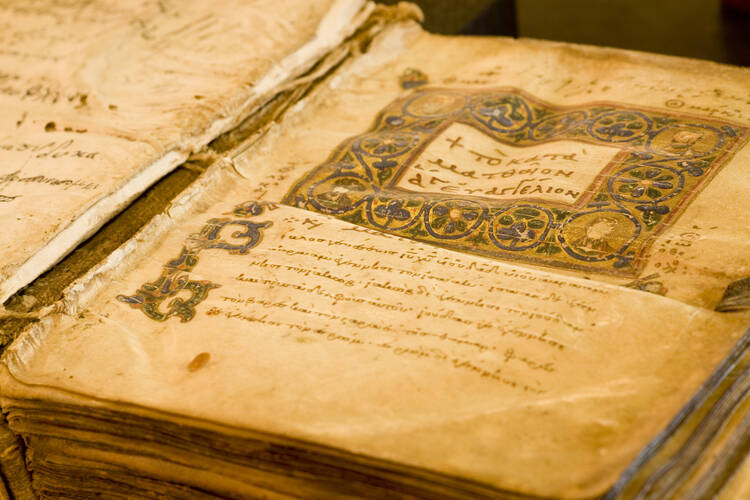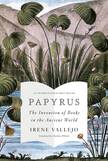Review: A history of books dating back to antiquity
At first glance, Papyrus looks like a typical work of book history, a straightforward exploration of the subject that journeys from scrolls to tablets to codices to modern books. However, Irene Vallejo’s first book translated into English is much more than a rehashing of classics like Marshall McLuhan’s TheGutenberg Galaxy or Robert Darnton’s The Case for Books.
Papyrus was a popular and critical success in its original Spanish for a reason. It found an audience outside of the academy because it speaks to present concerns and speaks on behalf of many book readers. The elements of memoir that punctuate the book will resonate with the kind of person who would pick Papyrus up off a bookstore shelf.
Vallejo holds a doctorate in philology and is a widely published author. In Spain, she is a major public intellectual. Her writings include novels, children’s books, accounts of classical authors and syndicated columns on current events.
A history of books dating back to antiquity, Papyrus feels like the culmination of two decades of reading and writing about classical literature. Much of the book is spent, in the fashion of The Education of Henry Adams, describing the intellectual journey of the author. Vallejo tells us she was herself late to embrace reading silently, a sensibility she shares with the ancients she studies—who often read aloud. She so loved being read to by her mother that she was hesitant to take on the guise of a silent reader. But when she did, she took to the bookish life with great vigor, subjecting herself to the ridicule of peers who found her passion for reading bizarre.
Irene Vallejo's Papyrus feels like the culmination of two decades of reading and writing about classical literature.
Into adulthood, Vallejo struggled to be accepted as a peer at Oxford University, where she had to jump through numerous bureaucratic and even ritualistic hoops to gain access to the books she wanted to peruse. Her desire simply to appreciate the collections of Bodleian and Sackler were regarded with suspicion in even the most erudite of spaces on earth.
In Papyrus, Vallejo delves into the culture of books and libraries that developed in Greece and Rome. She focuses on the Great Library of Alexandria, detailing the growth of the collection and its emergence as one of the most significant centers of learning in the ancient world, before examining its long decline under Roman rule and its eventual destruction during the third century A.D.
At times, Papyrus is a present-minded defense of Hellenistic and Roman learning, demonstrating that many of the social, cultural and political concerns of the third century B.C. or second century A.D. are abundant in slightly different vessels in 2023. Papyrus is simultaneously a tribute to the inner and outer lives of a reader and to the spaces they inhabit—libraries.
Vallejo differentiates between the intent of those who erect libraries, such as the Great Library of Alexandria, which might be anachronistically described as demi-Calvinist in its aspirations to serve as an outward sign of the inner erudition of its Ptolemaic founders and benefactors, and those who inhabit libraries. Library patrons, even back in the days of ancient Alexandria, were a transnational affinity group that made use of their shared space to engage in individual and collective pursuits—reading, listening, scholarship and writing. At that time, a library was conceived of as a public space and marketplace of ideas. Fierce disagreements arose among the patrons of the Great Library of Alexandria; but, in the words of Vallejo, the library itself served as a kind of “cease-fire zone” among conflicting ideas and individuals.
“On the shelves of Alexandria, borders were dissolved, and the words of the Greeks, the Jews, the Egyptians, the Iranians, and the Indians finally coexisted in peace,” Vallejo writes. The romance of that nearly universal library in Alexandria was the fullest expression of Hellenism, which the author describes as a kind of “proto-globalization” that spread the ideas of Athens and its environs from Anatolia to the Indian subcontinent. This sensibility is in keeping with a current trend in academia that glamorizes empires as vibrant polyglot societies while denigrating nations as progenitors of all the worst of modern impulses. Time will tell if this enthusiasm for empire among scholars will remain as the global political climate seems primed for a shift back to imperialism.
Many aspects of this book are not intellectually fashionable. The author certainly takes the idea of censorship to task, putting her at odds with significant portions of both ends of the political spectrum. Vallejo encourages readers to take a step back from the almost-gleeful arms race on both the left and right to remove apparently objectionable content from circulation. She notes that efforts in antiquity as well as the present to curb the circulation of existing ideas have rarely been successful. Where censorship succeeds is in suppressing new ideas through self-censorship, whereby writers avoid risk and thereby impoverish the public discourse. In Vallejo’s rendering, the free expression of ideas is an extension of the project first adopted at the Library of Alexandria.
Papyrus is a work of striking erudition that demonstrates the influence of cinema as much as of literature.
However, books and ideas find a way to persist. One of the most arresting stories in Papyrus is that of Galya Safonova, who was born in the Soviet gulag in the early 1940s. Her mother, an epidemiologist, had been confined in a prison camp for refusing to snitch on a colleague. Writing was strictly prohibited in the camps. Thus, Galya spent her childhood reading the books her mother had secretly sown together with cloth in the Siberian night, featuring words and pictures scrawled with a quill.
Vallejo meanders in her points in Papyrus. At one moment, the subject is Diocletian persecuting Christians; next up is a discussion of college curriculums purging authors like Plato and Descartes for allegedly aiding and abetting racism and colonialism; then the author will venture into a series of anecdotes about her own experiences as a research fellow at the Sackler and Bodleian Libraries at Oxford. Nevertheless, this bricolage approach works well.
Papyrus is a work of striking erudition that demonstrates the influence of cinema as much as of literature. This is a book made up of landscapes, montages and jump cuts. A film adaptation of Papyrus could well be an art house hit in the vein of “Helvetica” (2007) or “Exit Through the Gift Shop” (2010), particularly in the niche-friendly age of streaming.
PEN Award-winning editor Charlotte Whittle translated the book into English. The text in English has an often lyrical quality that reads well and sounds great when read aloud. Since the book discusses in some detail ancient disputes about the propriety of silent reading, I took a stab at reciting several passages from the book out loud. In each instance, the words presented just as well to my ears as they did to my eyes.
Papyrus is a unique contribution to the history of literacy, libraries and the book. It will never be regarded as the standard work on libraries because its tone and content are so unusual, but it may well become an essential book on the subject. Its contributions are moored to the voice of its author, who will be an easily relatable figure for the book’s readership.
This article also appeared in print, under the headline “All By The Book,” in the July and August 2023, issue.











